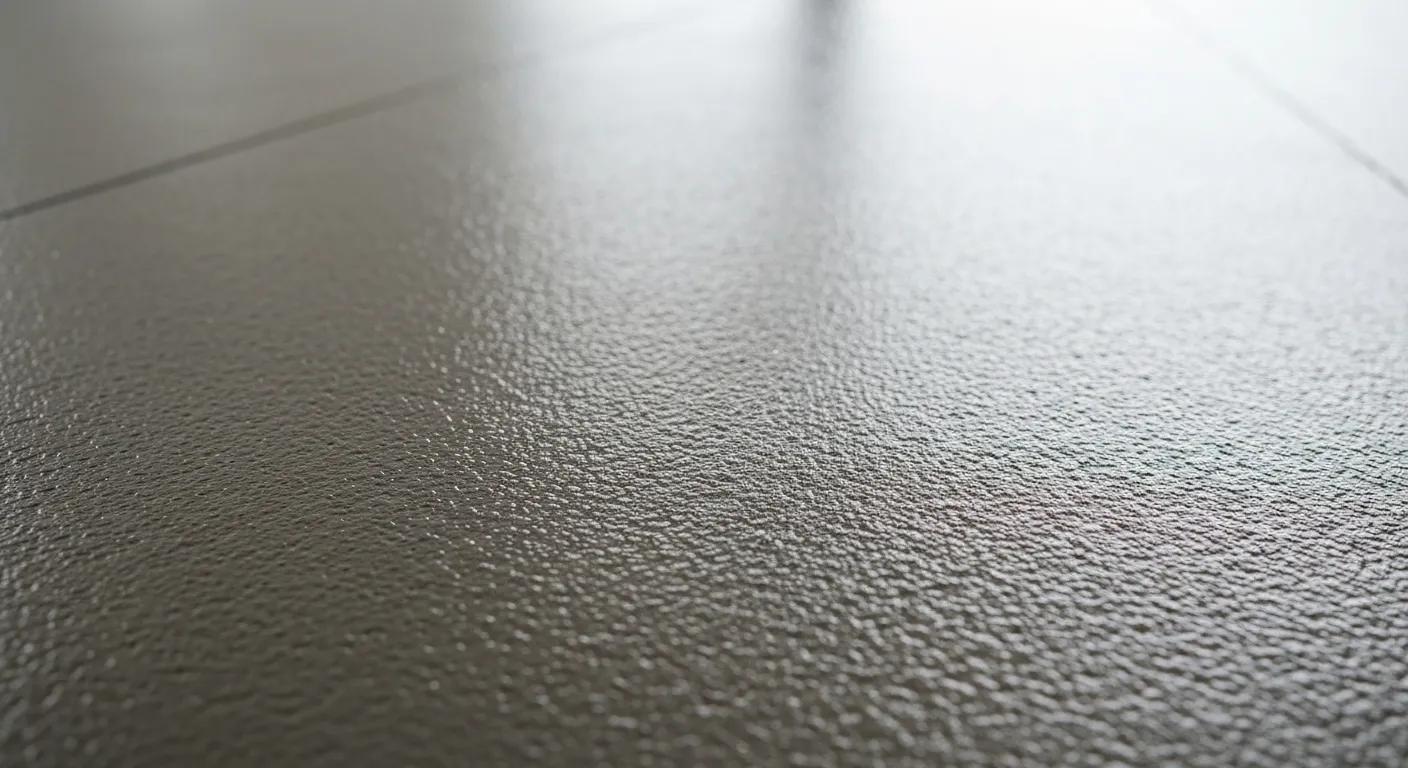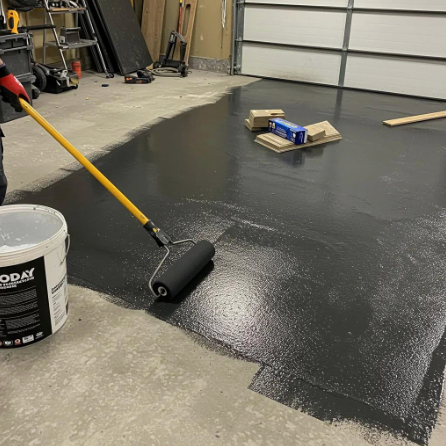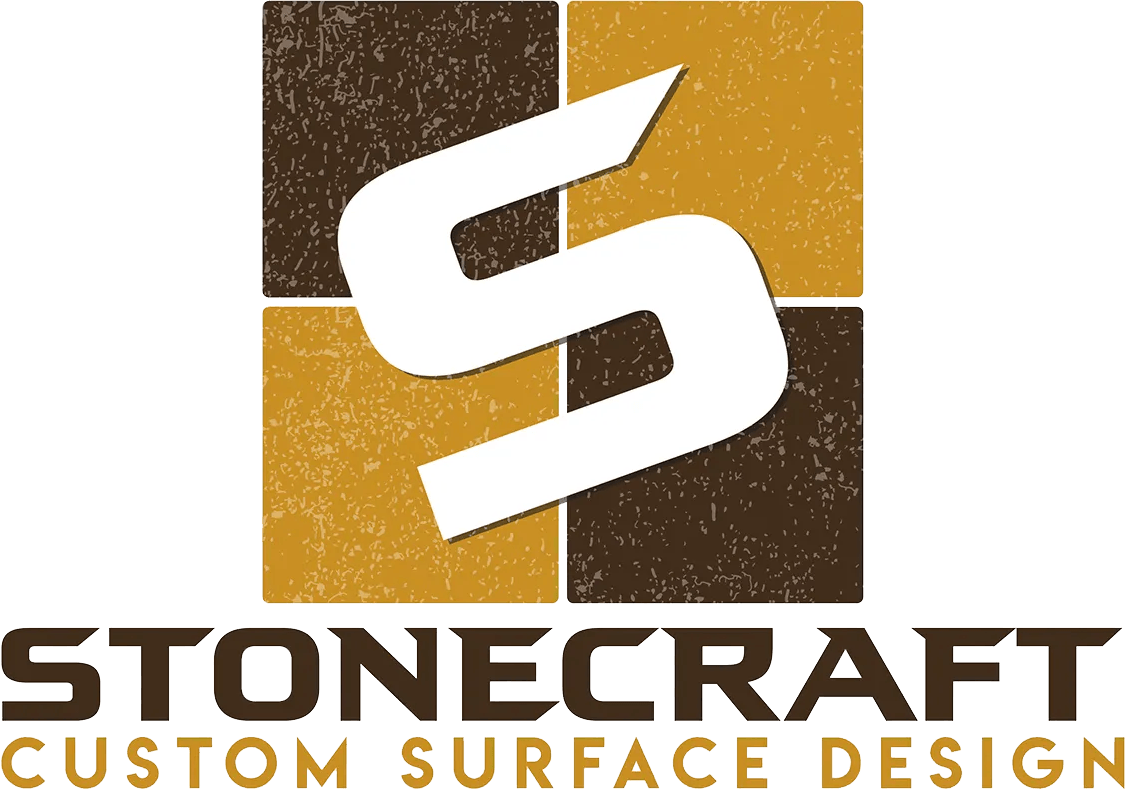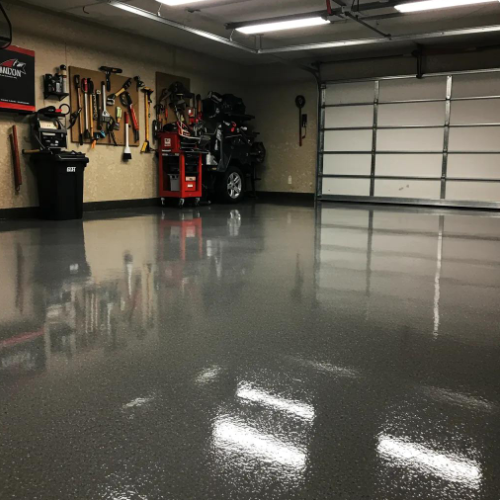Commercial Epoxy Flooring in NJ: The 1-Day Polyaspartic System Built for Heavy-Duty Businesses
Commercial Epoxy Flooring in NJ: The 1-Day Polyaspartic System Built for Heavy-Duty Businesses

Commercial epoxy flooring in New Jersey increasingly favors fast-curing, polyaspartic systems that return heavy-duty spaces to service within a single business day while delivering industrial-grade durability. This article explains what a 1-Day Polyaspartic System is, how its chemistry and layered construction create UV-stable, abrasion- and chemical-resistant surfaces, and why facility managers for warehouses, showrooms, and food or medical businesses prioritize reduced downtime. Readers will learn the technical features of polyaspartic and epoxy systems, the specific benefits for heavy traffic and chemical exposure, industry-by-industry recommendations, and transparent cost guidance for New Jersey projects. The piece also maps Stonecraft’s local service offering and installation approach where relevant, so facility owners can link the technical case for polyaspartic coatings to a practical regional provider. First we define the system and its components, then we walk through benefits, industry use cases, cost drivers, Stonecraft’s local process, and common buyer questions to support an informed specification decision.
What Is the 1-Day Polyaspartic Flooring System for Commercial Use in New Jersey?
A 1-Day Polyaspartic System is a rapid-cure, multi-layer concrete coating that uses polyaspartic topcoats over a prepared primer and base to deliver a seamless, UV-stable, and abrasion-resistant surface suitable for commercial flooring. The mechanism combines a high-adhesion primer, a high-build base layer (often with aggregate or quartz broadcast for mechanical strength), and a polyaspartic topcoat that chemically crosslinks quickly to minimize cure time and service interruption. The specific benefit is operational uptime: facilities can often be back in service within hours rather than days, which reduces lost revenue and scheduling complexity. In New Jersey environments where sun-exposed showrooms or chemically active service bays exist, polyaspartic’s UV stability and chemical resistance reduce maintenance and preserve appearance. Understanding these core layers and their functions clarifies how polyaspartic differs from traditional epoxy and why it suits heavy-duty commercial scenarios, which leads into a closer look at the coating’s defining features.
What Are the Key Features of Polyaspartic Floor Coatings?

Polyaspartic floor coatings feature exceptionally fast cure times, excellent UV stability, strong abrasion resistance, and broad chemical resistance, making them suitable for continuous forklift traffic and frequent cleaning cycles. Chemically, polyaspartics cure through rapid polyaddition that forms dense crosslinked networks, which increases hardness and reduces solvent uptake compared with some epoxies; this mechanism explains their quick return-to-service profile. Aesthetic options include solid colors, metallics, and mortar-style finishes, and aggregate broadcasts improve impact resistance and load distribution for heavy machinery areas. These attributes make polyaspartic coatings a practical choice where both functional performance and long-term appearance matter, and they set up the next topic: how one-day installations translate into business value.
How Does the 1-Day Installation Benefit Heavy-Duty Businesses?
A one-day schedule compresses substrate prep, priming, base coat broadcast, and the polyaspartic topcoat into a single operational window, which greatly reduces planned downtime and avoids multi-day closures. The result is measurable business benefit: fewer lost shifts, simplified scheduling for deliveries, and less disruption to customer-facing sales floors, all of which improve short-term cash flow and long-term operational reliability. Rapid cure also reduces temporary containment needs and labor staging costs, since crews demobilize faster and the space returns to full service quickly. These operational advantages make polyaspartic particularly valuable where uptime is critical, and they naturally lead to comparing lifecycle benefits versus maintenance requirements.
What Are the Benefits of Commercial Epoxy and Polyaspartic Flooring for Heavy-Duty Businesses in NJ?
Commercial epoxy and polyaspartic systems provide long-term durability, streamlined maintenance, and safety improvements that reduce total cost of ownership for heavy-duty businesses. The mechanism of value arises from seamless, monolithic surfaces that resist intrusion by oils, solvents, and other chemicals, reducing substrate deterioration and simplifying cleaning protocols. Cost savings accrue through lower maintenance frequency, reduced need for patch repairs, and extended service intervals compared with uncoated concrete; these financial benefits support ROI arguments for facility upgrades. The combination of abrasion resistance and customizable slip-resistant aggregate options improves workplace safety and helps facilities meet relevant operational standards.
Key attribute comparison (replaces table):
- Polyaspartic (1-Day System) – Cure time: Reopens to light traffic within hours; full chemical service the same day.
- Polyaspartic (1-Day System) – UV resistance: High, with minimal yellowing over years in sun-exposed areas.
- High-build Epoxy – Cure time: Typically 24–72 hours to initial cure, with longer timelines to full service.
- High-build Epoxy – Typical lifespan: Around 5–15 years depending on traffic and maintenance.
- Quartz/aggregate broadcast – Slip resistance: Enhanced traction with customizable slip ratings for safety.
This comparison clarifies where polyaspartic systems deliver faster uptime and improved UV stability while high-build epoxies offer proven durability in certain heavy-abrasion contexts. Transitioning from these comparative attributes, the next subsection explains how coatings achieve chemical and mechanical protection in practice.
How Do These Floors Provide Durability and Chemical Resistance?
Durability and chemical resistance stem from three combined mechanisms: a high-adhesion primer to lock the system to concrete, aggregate reinforcement to distribute loads, and a chemically robust topcoat that resists solvents and oils. The coating chemistry forms a continuous barrier that prevents chemical migration into the substrate, and thicker topcoats with appropriate aggregate broadcast resist gouging from forklifts and dropped tools. In practice, environments exposed to fuels, hydraulic fluids, or concentrated cleaning agents benefit from specifying systems with documented chemical resistance and sufficient topcoat thickness. Real-world examples include loading docks and maintenance bays where the surface prevents staining and structural degradation, which leads naturally into considerations about UV stability and abrasion performance.
Why Is UV Stability and Abrasion Resistance Important for Industrial Floors?
UV stability preserves color and gloss in sunlit showrooms, exterior canopies, and areas with large windows, preventing the yellowing and chalking that degrade brand appearance over time. Abrasion resistance ensures that repeated mechanical contact—such as pallet jacks, forklifts, and abrasive cleaning—does not prematurely thin the protective layer, which would otherwise expose concrete to wear and moisture ingress. Choosing a UV-stable polyaspartic topcoat or a UV-resistant epoxy variant directly reduces long-term maintenance cycles and preserves slip-resistant textures. Understanding these durability trade-offs helps facilities select coatings that balance aesthetic retention with load-bearing and cleaning demands, setting up recommended industry applications.
Which Industries and Commercial Spaces in New Jersey Use Polyaspartic and Epoxy Flooring?
Many New Jersey industries adopt polyaspartic and epoxy coatings where durability, hygiene, and uptime are mission-critical; typical adopters include warehouses, retail showrooms, manufacturing, commercial kitchens, medical facilities, and auto service centers. Each industry emphasizes different attributes—load capacity and abrasion resistance for warehouses, aesthetic finish and showroom branding for retail, hygienic seamless surfaces and regulatory compliance for food and medical settings, and chemical and oil resistance for auto shops. Mapping these requirements to systems helps owners specify coatings that meet performance targets while controlling lifecycle costs.
Industry requirements & recommended systems (replaces table):
- Warehouses: Need heavy load tolerance and abrasion resistance → quartz or aggregate broadcast with a polyaspartic topcoat.
- Showrooms: Require strong aesthetics and UV stability → solid-color or metallic polyaspartic finishes.
- Manufacturing: Demand chemical resistance and quick cure → high-build epoxy with a polyaspartic topcoat for faster return to service.
- Commercial kitchens: Focus on hygiene and slip resistance → seamless epoxy or polyurethane cement with a non-slip broadcast.
- Medical facilities: Require sterility-friendly, seamless surfaces → low-VOC epoxy with coved transitions and high cleanability.
What Makes These Floors Ideal for Warehouses, Showrooms, and Manufacturing Facilities?
For warehouses and manufacturing facilities, seamless coatings absorb impact and distribute loads across a reinforced matrix, which reduces spalling and localized concrete failure under concentrated loads. Aggregate broadcasts improve traction and protect the topcoat from mechanical abrasion by forklifts, while dense topcoats minimize dusting and particulates critical to automated inventory systems. Showrooms benefit from high-gloss, UV-stable polyaspartic finishes that maintain color and sheen under sunlight, supporting brand presentation and customer experience. These functional and aesthetic advantages explain why many facility managers choose engineered coatings for operational longevity, and they lead into how hygienic and regulatory needs shape choices for kitchens and medical sites.
How Do Commercial Kitchens, Medical Facilities, and Auto Dealerships Benefit from Specialized Flooring?
Commercial kitchens and medical facilities require seamless, coved surfaces that resist bacterial ingress and stand up to strong detergents and frequent sanitation cycles, which epoxy and polyurethane systems can provide when specified for low-VOC and compliance-friendly chemistry. Auto dealerships and service areas need oil- and solvent-resistant surfaces with strong abrasion resistance to withstand lifts, jacks, and chemical spills; broadcast systems with robust topcoats offer this protection while simplifying cleanup. Slip-resistant textures and appropriate rating choices (R or COF values) reduce accident risk and support operational safety programs. These compliance and hygiene-driven priorities shape both material selection and maintenance protocols, and they naturally lead to cost considerations for specification and budgeting.
How Much Does Commercial Epoxy Flooring Cost in New Jersey?
Cost for commercial epoxy and polyaspartic systems varies with surface condition, system complexity, square footage, and downtime requirements; typical heavy-duty commercial installations in New Jersey fall within distinct price bands depending on selected components. Surface preparation and repair often represent a significant portion of the budget because concrete grinding, crack repair, and moisture mitigation are labor-intensive but essential for adhesion and longevity. Systems that include quartz or aggregate broadcast and polyaspartic topcoats command higher per-square-foot prices but reduce lifecycle maintenance costs.
Representative cost factors & ranges (replaces table):
- Basic epoxy – Surface prep and repair: Roughly $2.50–$4.50 per sq ft depending on slab condition.
- Broadcast epoxy – Material and installation complexity: Typically around $5.00–$9.00 per sq ft.
- 1-Day polyaspartic system – Fast-cure premium topcoat: Often in the $6.00–$12.00 per sq ft range.
- Moisture mitigation – Vapor barrier and testing: Commonly adds $1.50–$4.00 per sq ft when required.
This cost breakdown shows how prep, system type, and specialty topcoats move a project across budget tiers. After understanding cost drivers, owners should consider specific factors that influence where their project will land in these ranges.
What Factors Affect the Cost of Polyaspartic and Epoxy Floor Coatings?
Surface preparation is often the single largest variable: poor concrete requires more grinding, patching, and moisture remediation, which increases labor and materials costs. The selected system—basic epoxy, quartz broadcast, flake, or polyaspartic topcoat—changes material expense and installation time; decorative options and color matching add marginal costs. Accessibility, schedule constraints, and the desire for a one-day turnaround can increase labor rates, since compressed schedules require larger crews and expedited sequencing. Understanding these drivers helps owners evaluate estimates and choose tradeoffs between upfront cost and lifecycle performance, guiding the decision to pursue expedited systems for operational reasons.
What Is the Typical Price Range per Square Foot for Heavy-Duty Commercial Floors?
Representative price bands for heavy-duty commercial floors reflect project complexity: budget epoxy repairs and coatings may start in the low single digits per square foot, quartz broadcast systems often occupy the mid-range, and premium 1-Day polyaspartic installations with aggregate broadcast sit at the higher end. Scenarios with extensive substrate repair, moisture mitigation, or specialized anti-slip specifications push projects toward the top of the range, while adequately prepared concrete and straightforward color choices keep costs lower. These ranges are estimates; facility owners should obtain an on-site evaluation for a precise quote. Provide and install specialized concrete and epoxy flooring solutions for both residential and commercial clients in the Lakewood, NJ area and surrounding regions.
How Does Stonecraft NJ Deliver Superior Commercial Epoxy and Polyaspartic Flooring Services?
Stonecraft combines product selection, installation discipline, and local project management to translate technical coating specifications into reliable, low-downtime commercial floors for New Jersey clients. Provide and install specialized concrete and epoxy flooring solutions for both residential and commercial clients in the Lakewood, NJ area and surrounding regions. Their approach emphasizes surface assessment, premium-grade materials with lifetime warranty claims in marketing, and a workflow that targets minimal interruption—matching the one-day polyaspartic value proposition. Local coordination with site teams and transparent estimates help owners balance cost, downtime, and performance objectives. The next subsections outline Stonecraft’s typical installation sequence and the reasons clients choose their services in Lakewood and surrounding communities.
What Is Stonecraft’s Installation Process for the 1-Day Polyaspartic System?

Stonecraft’s 1-Day Polyaspartic installation process begins with a thorough substrate assessment and concrete profiling, typically involving grinding and targeted repairs to ensure adhesion and flatness. The crew then applies a primer to bond the system, followed by a base coat with optional aggregate or quartz broadcast for mechanical strength; after broadcast and profile cleanup, a polyaspartic topcoat is applied and allowed to reach its rapid serviceable cure. Post-install inspection confirms adhesion, slip-resistance, and appearance, and warranty documentation and maintenance guidance are provided to the client. Provide and install specialized concrete and epoxy flooring solutions for both residential and commercial clients in the Lakewood, NJ area and surrounding regions.
- Assessment and Prep: Inspect substrate, perform grinding, and make repairs to ensure a sound surface for coating.
- Priming and Base Coat: Apply primer and a base layer for adhesion and build before broadcasting aggregate if required.
- Topcoat and Cure: Apply polyaspartic topcoat; allow rapid cure and perform final inspection and documentation.
Why Choose Stonecraft for Commercial Flooring in Lakewood and Surrounding NJ Areas?
Stonecraft emphasizes local responsiveness, product-grade selection, and customer service focused on minimizing operational disruption while delivering durable finishes backed by warranty statements in their promotional content. Provide and install epoxy flooring solutions for both residential and commercial clients in the Lakewood, NJ area and surrounding regions. Their local Lakewood presence facilitates rapid scheduling and site visits, and their service scope includes epoxy flooring, decorative overlays, textured concrete, and polished concrete—services that support integrated floor lifecycle management. For facility managers seeking technical performance and streamlined installation, Stonecraft’s combination of local coordination and premium materials offers a practical option. The next section answers common buyer questions that typically arise during specification and procurement.
What Are Common Questions About Commercial Epoxy and Polyaspartic Flooring in NJ?
Buyers routinely ask about lifespan, maintenance, differences between epoxy and polyaspartic systems, and local service availability; clear answers to these topics assist procurement and operations planning. Concise responses help PAA and featured-snippet style queries while guiding specification choices. The following subsections address typical lifespan expectations and head-to-head differences to support a final selection.
How Long Does Commercial Epoxy Flooring Last in Heavy-Duty Environments?
Commercial epoxy and polyaspartic floors typically last between five and fifteen years in heavy-duty environments when correctly specified and maintained, with lifespan depending on traffic intensity, chemical exposure, and maintenance regimes. Regular cleaning, periodic resealing or topcoat refreshes, and prompt repair of localized damage extend service life and protect substrate integrity. Systems that include quartz broadcast and thicker topcoats perform better under constant forklift traffic and abrasive conditions, while polyaspartic topcoats can reduce maintenance frequency due to UV stability and harder surface characteristics. Comparing these lifespan drivers helps owners weigh upfront cost against long-term replacement and maintenance expenses.
What Are the Differences Between Epoxy and Polyaspartic Flooring for Commercial Use?
Epoxy and polyaspartic systems differ primarily in cure time, UV stability, and price-performance trade-offs: polyaspartics cure far faster and resist UV-induced yellowing, while traditional epoxies often provide excellent adhesion and are cost-effective where extended cure windows are acceptable. Polyaspartic topcoats reduce downtime and preserve appearance in sun-exposed areas, making them ideal for showrooms and exterior canopies, whereas high-build epoxies paired with broadcast aggregates excel in extreme abrasion scenarios at potentially lower initial cost. Decision-making should follow a systems-based assessment: evaluate substrate condition, required downtime, chemical exposures, and appearance expectations to select the optimal coating. Provide and install specialized concrete and epoxy flooring solutions for both residential and commercial clients in the Lakewood, NJ area and surrounding regions.
The body content of your post goes here. To edit this text, click on it and delete this default text and start typing your own or paste your own from a different source.



